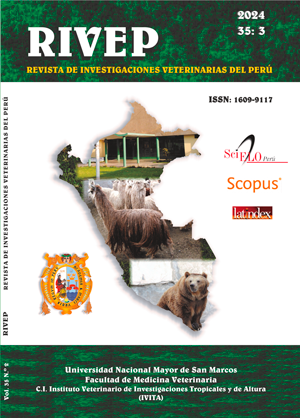Determinación de Fasciola hepatica y parásitos gastrointestinales en ovinos de la comuna de San Clemente, Chile
DOI:
https://doi.org/10.15381/rivep.v35i3.28269Palabras clave:
prevalencia, ovinos, helmintos, Fasciola hepatica, parásitosResumen
Se determinó la presencia de parásitos gastrointestinales (PGI) en ovinos de carne provenientes de predios de la precordillera de la comuna de San Clemente Chile mediante un muestreo por conveniencia (n=100) entre agosto y noviembre de 2022. Se colectaron muestras fecales del recto y se procesaron mediante la técnica de sedimentación de Dennis modificada para la determinación de huevos de F. hepatica y la técnica de flotación de Sheather para determinación de huevos de nemátodos y coccidias. Además, se realizó la técnica cuantitativa de McMaster modificado en las muestras. Se encontró mayor prevalencia de parásitos de la familia Trichostrongylidae (68%), seguido de F. hepatica (47%), Nematodirus sp (25%) y Eimeria sp (43%). Además, se evaluaron las variables epidemiológicas edad, sexo y estado sanitario. El grupo etario fue significativo (p=0.003) para la variable edad en Trichostrongylidae, y el tipo de manejo sanitario afectó la prevalencia de Eimeria (p=0.020); Trichostrongylidae (p=0.001); Nematodirus sp (p=0.04) y Fasciola hepatica (p=0.020). Se detectaron cargas parasitarias moderadas en todos los casos. Asimismo, se detectaron casos de biparasitisimo (26%) y multi-parasitismo (32%).
Descargas
Descargas
Publicado
Número
Sección
Licencia
Derechos de autor 2024 Tamara Muñoz-Caro, Pamela Quiroz, Nicolás Maldonado, Jocelyn Maripangui, Marcela Gómez, Lina Gomez, Alejandro Hidalgo

Esta obra está bajo una licencia internacional Creative Commons Atribución 4.0.
LOS AUTORES RETIENEN SUS DERECHOS:
a. Los autores retienen sus derechos de marca y patente, y tambien sobre cualquier proceso o procedimiento descrito en el artículo.
b. Los autores retienen el derecho de compartir, copiar, distribuir, ejecutar y comunicar públicamente el articulo publicado en la Revista de Investigaciones Veterinarias del Perú (RIVEP)(por ejemplo, colocarlo en un repositorio institucional o publicarlo en un libro), con un reconocimiento de su publicación inicial en la Revista de Investigaciones Veterinarias del Perú (RIVEP).
c. Los autores retienen el derecho a hacer una posterior publicación de su trabajo, de utilizar el artículo o cualquier parte de aquel (por ejemplo: una compilación de sus trabajos, notas para conferencias, tesis, o para un libro), siempre que indiquen la fuente de publicación (autores del trabajo, revista, volumen, numero y fecha).



